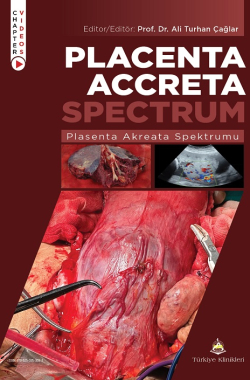Conservative Management
Assoc. Prof. Dr. Burak Bayraktar1
Prof. Dr. Şevki Çelen2
1Department of Perinatology, Ankara Etlik City Hospital, Ankara, Türkiye
2Department of Perinatology, Ankara Etlik City Hospital, Ankara, Türkiye
ABSTRACT
Placenta accreta spectrum (PAS) disorders, encompassing placenta accreta, increta, and percreta, represent a significant challenge in obstetrics due to their association with severe maternal morbidity and mortality. These conditions involve abnormal adherence of the placenta to the myometrium, often leading to life-threatening hemorrhage during delivery. While cesarean hysterectomy has been the traditional treatment, it poses con- siderable risks, such as massive blood loss, infection, and organ injury. In contrast, conservative management aims to preserve fertility while reducing surgical morbidity. Candidates for conservative management include patients desiring future fertility, those at high risk for hysterectomy complications, and cases with focal accre- ta or favorable placental location. Key strategies include preoperative imaging for detailed planning, intraop- erative techniques like leaving the placenta in situ, one-step conservative surgery, and the Triple-P procedure. Postoperative care involves close monitoring for complications like hemorrhage and infection. Although con- servative management carries risks such as recurrence in future pregnancies, it remains a valuable option for selected patients when performed by an experienced multidisciplinary team.
Keywords: Placenta accreta spectrum; Conservative management; Uterine preservation; Fertility preservation; Leaving placenta in situ; One-step conservative surgery; Triple-P procedure; Maternal morbidity
Kaynak Göster
Referanslar
- Golbasi H, Bayraktar B, Golbasi C, et al. Expected Ver- sus Unexpected Delivery for Placenta Accreta Spectrum (PAS) Disorders with Same Team in Single Tertiary Cen- ter. Z Für Geburtshilfe Neonatol. 2022;226(06):391-398. [Crossref] [PubMed]
- Vural T, Bayraktar B, Karaca SY, Golbasi C, Odabas O, Tan- er CE. Indications, risk factors, and outcomes of emergency peripartum hysterectomy: A 7-year retrospective study at a tertiary center in Turkey. Malawi Med J. 2023;35(1):31-42. [Crossref] [PubMed]
- Patabendige M, Sanjeewa JMP, Amarasekara AM a. KG, Herath RP. Conservative Management of Placenta Percreta: Three Cases and a Review of the Literature regarding Con- servative Management of Placenta Accreta Spectrum (PAS) Disorders. Case Rep Obstet Gynecol. 2020;2020:9065342. [Crossref] [PubMed]
- Abbas RA, Nassar AH. Placenta Accreta Spectrum: Con- servative Management and Its Impact on Future Fertil- ity. Maternal-Fetal Med. 2021;3(4):263. [Crossref]
- Sentilhes L, Ambroselli C, Kayem G, et al. Maternal outcome after conservative treatment of placenta accreta. Obstet Gynecol. 2010;115(3):526-534. [Crossref]
- Fox KA, Shamshirsaz AA, Carusi D, et al. Conserva- tive management of morbidly adherent placenta: expert review. Am J Obstet Gynecol. 2015;213(6):755-760. [Crossref] [PubMed]
- Babaei MR, Oveysi Kian M, Naderi Z, et al. Methotrexate infusion followed by uterine artery embolisation for the man- agement of placental adhesive disorders: a case series. Clin Radiol. 2019;74(5):378-383. [Crossref] [PubMed]
- Soyer P, Barat M, Loffroy R, et al. The role of interventional radiology in the management of abnormally invasive placen- ta: a systematic review of current evidences. Quant Imaging Med Surg. 2020;10(6):1370391-1371391. [Crossref] [PubMed]
- Kutuk MS, Ak M, Ozgun MT. Leaving the placenta in situ versus conservative and radical surgery in the treatment of placenta accreta spectrum disorders. Int J Gynecol Ob- stet. 2018;140(3):338-344. [Crossref] [PubMed]
- Matsuzaki S, Yoshino K, Endo M, Kakigano A, Takiuchi T, Kimura T. Conservative management of placenta percreta. Int J Gynaecol Obstet Off Organ Int Fed Gynaecol Ob- stet. 2018;140(3):299-306. [Crossref] [PubMed]
- Kim TH, Lee HH, Kwak JJ. Conservative management of abnormally invasive placenta: choriocarcinoma with uterine arteriovenous fistula from remnant invasive placenta. Acta Obstet Gynecol Scand. 2013;92(8):989-990. [Crossref] [PubMed]
- Kayem G, Davy C, Goffinet F, Thomas C, Clément D, Ca- brol D. Conservative versus extirpative management in cases of placenta accreta. Obstet Gynecol. 2004;104(3):531-536. [Crossref] [PubMed]
- Collins SL, Alemdar B, van Beekhuizen HJ, et al. Evi- dence-based guidelines for the management of abnormally invasive placenta: recommendations from the International Society for Abnormally Invasive Placenta. Am J Obstet Gy- necol. 2019;220(6):511-526. [Crossref] [PubMed]
- Palacios Jaraquemada JM, Pesaresi M, Nassif JC, Hermo- sid S. Anterior placenta percreta: surgical approach, he- mostasis and uterine repair. Acta Obstet Gynecol Scand. 2004;83(8):738-744. [Crossref] [PubMed]
- Palacios-Jaraquemada JM, Fiorillo A, Hamer J, Martínez M, Bruno C. Placenta accreta spectrum: a hysterectomy can be prevented in almost 80% of cases using a resec- tive-reconstructive technique. J Matern Fetal Neonatal Med. 2022;35(2):275-282. [Crossref] [PubMed]
- Chandraharan E, Rao S, Belli AM, Arulkumaran S. The Tri- ple-P procedure as a conservative surgical alternative to peri- partum hysterectomy for placenta percreta. Int J Gynaecol Obstet Off Organ Int Fed Gynaecol Obstet. 2012;117(2):191-194. [Crossref] [PubMed]
- Provansal M, Courbiere B, Agostini A, D'Ercole C, Boubli L, Bretelle F. Fertility and obstetric outcome after conserva- tive management of placenta accreta. Int J Gynaecol Obstet Off Organ Int Fed Gynaecol Obstet. 2010;109(2):147-150. [Crossref] [PubMed]
- Sentilhes L, Kayem G, Ambroselli C, et al. Fertility and preg- nancy outcomes following conservative treatment for placen- ta accreta. Hum Reprod Oxf Engl. 2010;25(11):2803-2810. [Crossref] [PubMed]


